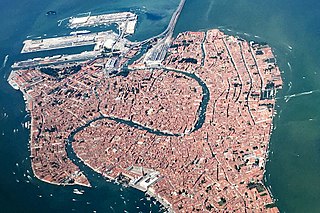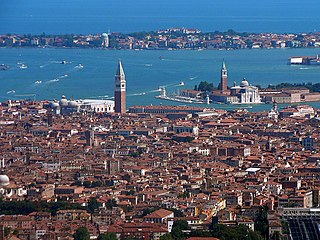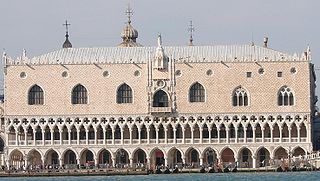
Venice is a residential, commercial, and recreational beachfront neighborhood within Los Angeles, California. It is located within the urban region of western Los Angeles County known as the Westside.

Milano Centrale is the main railway station of the city of Milan, Italy and is the largest train station in Europe by volume. The station is a terminus and located at the northern end of central Milan. It was officially inaugurated in 1931 to replace the old central station, which was a transit station but with a limited number of tracks and space, so could not handle the increased traffic caused by the opening of the Simplon tunnel in 1906.

The gondola is a traditional, flat-bottomed Venetian rowing boat, well suited to the conditions of the Venetian lagoon. It is similar to a canoe, except it is narrower. It is propelled by a gondolier, who uses a rowing oar, which is not fastened to the hull, in a sculling manner and acts as the rudder.

Vincenzo Scamozzi was an Italian architect and a writer on architecture, active mainly in Vicenza and Republic of Venice area in the second half of the 16th century. He was perhaps the most important figure there between Andrea Palladio, whose unfinished projects he inherited at Palladio's death in 1580, and Baldassarre Longhena, Scamozzi's only pupil.

The Republic of Venice or Venetian Republic, traditionally known as La Serenissima was a sovereign state and maritime republic in northeastern Italy, which existed for over a millennium between the 7th century and the 18th century from 697 AD until 1797 AD. It was based in the lagoon communities of the historically prosperous city of Venice, and was a leading European economic and trading power during the Middle Ages and the Renaissance.

The Grand Canal is a channel in Venice, Italy. It forms one of the major water-traffic corridors in the city.

The Rialto Bridge is the oldest of the four bridges spanning the Grand Canal in Venice, Italy. Connecting the sestieri (districts) of San Marco and San Polo, it has been rebuilt several times since its first construction as a pontoon bridge in the 12th century, and is now a significant tourist attraction in the city.

St Mark's Campanile is the bell tower of St Mark's Basilica in Venice, Italy, located in the Piazza San Marco. It is one of the most recognizable symbols of the city.

The Province of Venice was a province in the Veneto region of northern Italy. Its capital is the city of Venice. It had an area of 2,467 km², and a total population of 846,962 (2011). The province became the Metropolitan City of Venice by 1 January 2015.

Università Iuav di Venezia is a university in Venice, Italy. It was founded in 1926 as the Istituto Universitario di Architettura di Venezia, and has 3 departments.

Agnello Participazio was the tenth (traditional) or eighth (historical) Doge of Venice from 811 to 827.
Giustiniano Participazio was the eleventh (traditional) or ninth (historical) Doge of Venice from 825 to his death. His four years on the ducal throne were very eventful. He was made hypatus by the Byzantine emperor Leo V the Armenian.
Giovanni I Participazio was the tenth (historical) or twelfth (traditional) Doge of Venice from the death of his brother in 829 to his arrest and deposition in 836.

Domenico Selvo was the 31st Doge of Venice, serving from 1071 to 1084. During his reign as Doge, his domestic policies, the alliances that he forged, and the battles that the Venetian military won and lost laid the foundations for much of the subsequent foreign and domestic policy of the Republic of Venice. He avoided confrontations with the Byzantine Empire, the Holy Roman Empire, and the Roman Catholic Church at a time in European history when conflict threatened to upset the balance of power. At the same time, he forged new agreements with the major nations that would set up a long period of prosperity for the Republic of Venice. Through his military alliance with the Byzantine Empire, Emperor Alexios I Komnenos awarded Venice economic favors with the declaration of a Golden Bull that would allow for the development of the republic's international trade over the next few centuries.

Venezia Santa Lucia is the central station of Venice in the north-east of Italy. It is a terminus and located at the northern edge of Venice's historic city . The station is one of Venice's two most important railway stations; the other one is Venezia Mestre, a mainline junction station on Venice's mainland district of Mestre. Both Santa-Lucia and Mestre stations are managed by Grandi Stazioni and they are connected to each other by Ponte della Libertà.

Marco Cornaro, also known as Marco Corner, was the 59th doge of Venice, ruling between 1365 and 1368. His brief reign saw the loss of Venetian territory to Genoa and the Ottoman Empire, though Venice was to enjoy economic growth during this time.

Nicolò Tron was the 68th Doge of Venice, reigning from 1471 to 1473.

Udine railway station serves the city and comune of Udine, in the autonomous region of Friuli-Venezia Giulia, northeastern Italy. Opened in 1860, it is a junction of five lines, to Venice, Trieste, Tarvisio, Cervignano and Cividale, respectively.


















